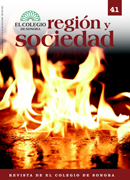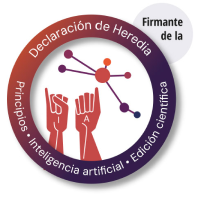 |
 |
 |
 |
 |
 |
 |
 |
 |
 |
 |
 |
Abstract
According to the human capital model, education is the main factor for improving income; wages are closely and directly linked to schooling: wages will be higher according to education level. In this article, we study the relationship between schooling, wages, and profits for private education, estimated at 10 per cent, produced by the education in the Mexican northern border states: Baja California, Sonora, Chihuahua, Coahuila, Nuevo Leon, and Tamaulipas. Workers that inhabit the relatively most developed cities like Tijuana, Mexicali, Ciudad Juarez, and Nuevo Laredo show a defined territorial income pattern and earn higher wages than the workers that live in areas which are less developed or farther from the northern border region.
References
Alarcón, Diana y Terry McKinley 1997. The Paradox of Narrowing Wage Differentials and Widening Wage Inequality in Mexico. Development and Change XXVIII (3): 505–530.
Almendarez, Marco. 2004. Un análisis económico de la relación ingresos–educación. Una aproximación de capital humano para México. Tesis de maestría en Economía Aplicada, El Colegio de la Frontera Norte.
Barceinas, Fernando y José Raymond. 2005. Convergencia regional y capital humano en México, de los años 80 al 2002. Estudios Económicos XX (2): 263–304.
Barceinas, Fernando. 1999. Función de ingresos y rendimiento de la educación en México. Estudios Económicos XIV (1): 87–127.
Becker, Gary. 1993. Human Capital: A Theoretical and Empirical Analysis with Special Reference to Education. Chicago: The University of Chicago Press.
Bracho, Teresa y Andrés Zamudio. 1994. Los rendimientos económicos de la escolaridad en México, 1989. Economía Mexicana III (2): 345–3 77.
Chiswick, Barry 1997. Interpreting the Coefficient of Schooling in the Human Capital Earnings Function. Working paper 1790. Washington: World Bank.
Cortez, Willy. 2002. Desigualdad salarial por entidad federativa en México, 1984–1998. Un análisis de sección cruzada. En Economía y desarrollo regional en México, compilado por Víctor Acevedo y José Navarro, 153–174. Morelia: Universidad de Guadalajara, Instituto de Investigaciones Económicas y Empresariales de la Universidad Michoacana de San Nicolás de Hidalgo y Centro de Estudios del Desarrollo A.C.
–––––––––– 2001. What is Behind Increasing Wage Inequality in Mexico? World Development XXIX (11): 1905–1922.
Garro, Nora, Marco Gómez y Jorge Meléndez. 1997. Situación ocupacional y niveles de ingreso de los trabajadores en relación con su educación y ocupación. México: Secretaría del Trabajo y Previsión Social. Reporte de investigación no. 212.
Ghiara, Ranjeeta y Eduardo Zepeda. 2004. Desigualdad salarial, demanda de trabajo calificado y modernización: lecciones del caso de Tijuana, 1987–1994. región y sociedad XVI (29): 3–43.
Gómez, Luisa y George Psacharopoulos. 1990. Earnings and Education in Ecuador: Evidence from the 1987 Household Survey. Economics and Education Review IX (3): 219–227.
Heckman, James. 1977. Sample Selection Bias as a Specification Error. Working paper 172. Cambridge: National Bureau of Economic Research.
Lachler, Ulrich. 1998. Education and Earnings Inequality in Mexico. Working paper 1949. Washington: World Bank.
Legovini, Arianna, César Bouillon y Nora Lustig. 2005. Can Education Explain Changes in Income Inequality in Mexico? En The Microeconomics of Income Distribution Dynamics in East Asia and Latin America, compilado por François Bourguignon, Francisco Ferreira y Nora Lustig, 275–313. Nueva York: World Bank y Oxford University Press.
Mendoza, Jorge. 2002. Educación, experiencia y especialización manufacturera en la frontera norte de México. Comercio Exterior LII (4): 300–308.
Mincer, Jacob. 1974. Schooling, Experience, and Earnings. Nueva York: National Bureau of Economic Research y Columbia University.
Psacharopoulos, George. 1994. Returns to Investment in Education: A Global Update. World Development XXII (9): 1325–1343.
–––––––––– 1985. Returns to Education: A Further International Update and Implications. The Journal of Human Resources xx (4): 583–604.
Psacharopoulos, George y H. Patrinos. 2002. Returns to Investment in Education: A Further Update. Working paper 2881. Washington: World Bank.
Psacharopoulos, George, Eduardo Vélez, Max Panagides y Hongyu Yang. 1996. Return to Education During Economic Boom and Recession: Mexico 1984, 1989 and 1992. Education Economics IV (3): 219–230.
Psacharopoulos, George y Y C. Ng. 1992. Earnings and Education in Latin America: Assessing Priorities for Schooling Investments. Working paper 1056. Washington: World Bank.
Rojas, Mariano, Humberto Angulo e Irene Velázquez. 2000. Rentabilidad de la inversión en capital humano en México. Economía Mexicana IX (2): 113–142.
Sariñana, J. 2002. Rendimiento de la escolaridad en México: una aplicación del método de variables instrumentales para 1998. Gaceta de Economía VII (14): 85–127.
Urciaga, José. 2004. Los impactos del territorio sobre los salarios: una aproximación empírica para México. Prospectiva Económica IV: 135–156.
–––––––––– 2002. Los rendimientos privados de la escolaridad formal en México. Comercio Exterior LII (4): 324–330.
Willis, R. y R. Sherwin. 1986. Wage Determinants: A Survey and Reinterpretation of Human Capital Earnings Functions. En Handbook of Labor Economics, compilado por Orley Ashenfelter y Richard Layard, 525–601. Amsterdam: North Holland–Elsevier Sciencie Publishers.
World Bank. 2000. Earnings Inequality after Mexico's Economic and Educational Reforms. Main Document and Background Papers, I y II (19945–ME).
Open access policy
The authors who publish in región y sociedad accept the following conditions:
In accordance with the copyright laws, región y sociedad recognizes and respects the authors’ moral rights, as well as the ownership of property rights, which will be transferred to the journal to disseminate the articles in open access. región y sociedad does not charge the authors for submitting and processing articles for publication.
All the texts published by región y sociedad —with no exception— are distributed under a Creative Commons license 4.0 Attribution – Noncommercial (CC BY-NC 4.0 International), which allows third parties to use the publication as long as they mention the works’ authorship and the first publication in this journal.
The authors can enter into independent and additional contractual agreements for the nonexclusive distribution of the version of the article published in región y sociedad (for instance include it into an institutional repository or publish it in a book) as long as they clearly indicate that the work was published for the first time in región y sociedad.
For all the above, the author(s) must send the Letter of transfer of property rights of the first publication duly filled in and signed by the author(s). This letter can be sent by e-mail as a PDF to: region@colson.edu.mx






